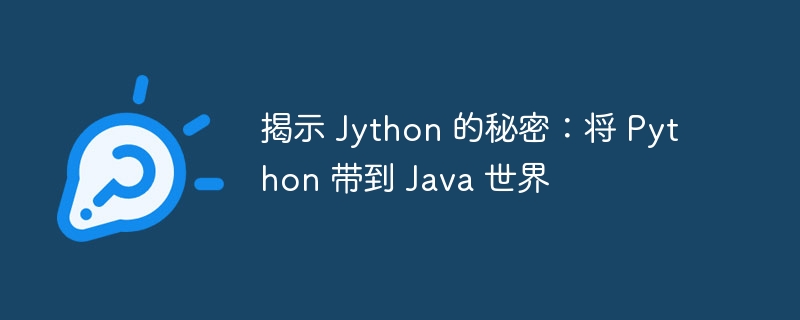Home >Backend Development >Python Tutorial >Revealing Jython's Secrets: Bringing Python to the Java World
Revealing Jython's Secrets: Bringing Python to the Java World
- WBOYWBOYWBOYWBOYWBOYWBOYWBOYWBOYWBOYWBOYWBOYWBOYWBforward
- 2024-03-23 20:10:02507browse

Integrating the power of Python
One of the core strengths of Jython is its ability to bring the dynamic nature of the python language to a Java environment. Python is known for its simple, readable syntax and extensive library, enabling developers to quickly create prototypes, perform data analysis and develop complexalgorithm. With Jython, Java developers can take advantage of these features while still taking advantage of Java's typesafety, concurrency, and vast ecosystem of libraries.
Seamless Java Integration
Jython is also a two-way bridge, allowing Python code to be tightly integrated with Java code. Python objects can interact with Java objects, and Java classes and methods can be called from Python code using Java api. This seamless integration enables developers to take advantage of the benefits of Python and Java in the same application, such as creating application logic in Python while handling the underlying infrastructure or interacting with other Java components in Java.
Wide range of applications
Jython's versatility makes it useful in a variety of applications, including:
- Script Automation: Jython can be used to automate Java applications or system tasks, leveraging Python's scripting capabilities.
- Data Science: Python is very popular in the field of data science, and Jython makes it easy to access and manipulate data from Java applications.
- Machine Learning: Jython can be used to deploy and execute Machine Learning models in a Java environment.
- Web Development: Through integration with the JAVA WEB Framework, Jython can be used to create dynamic WEB applications.
- Education and Research: Jython makes it easy to teach and explore the Python language in a Java environment, making it useful for education and research purposes.
Technical realization
Jython implements the Python interpreter in the JVM by using the Java Native Interface (JNI). JNI allows Python code to interact with Java code natively, making the integration process transparent. Jython also includes a mechanism called JavaBeans Bridge, which allows Python objects to be exposed as JavaBeans, further simplifying integration with Java code.
Best Practices and Considerations
When using Jython, follow the following best practices:
- Separate Python and Java code: Try to keep Python and Java code in different files or modules to avoid name conflicts and improve maintainability.
- Use type annotations: Jython supports type annotations, which helps improve the security, readability, and maintainability of your code.
- Attention to memory management: Python uses reference counting for memory management, which is different from Java's garbage collection. Please pay attention to the life cycle of Python objects to avoid memory leaks.
- Understand the performance impact: Jython code is typically slower than native Java code because Python is an interpreted language. In performance-critical applications, consider optimizing Python code or using a Java implementation.
The above is the detailed content of Revealing Jython's Secrets: Bringing Python to the Java World. For more information, please follow other related articles on the PHP Chinese website!

